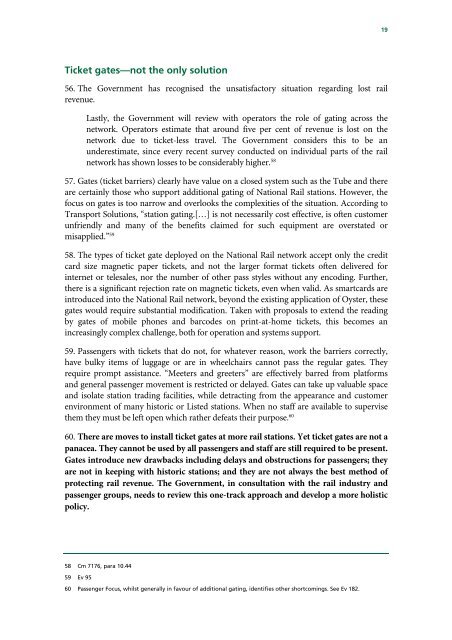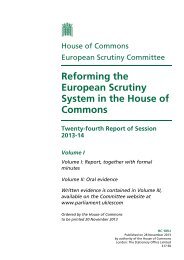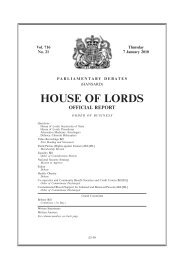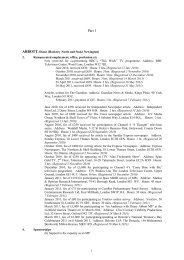Ticketing and Concessionary Travel on Public Transport - United ...
Ticketing and Concessionary Travel on Public Transport - United ...
Ticketing and Concessionary Travel on Public Transport - United ...
You also want an ePaper? Increase the reach of your titles
YUMPU automatically turns print PDFs into web optimized ePapers that Google loves.
Ticket gates—not the <strong>on</strong>ly soluti<strong>on</strong><br />
56. The Government has recognised the unsatisfactory situati<strong>on</strong> regarding lost rail<br />
revenue.<br />
Lastly, the Government will review with operators the role of gating across the<br />
network. Operators estimate that around five per cent of revenue is lost <strong>on</strong> the<br />
network due to ticket-less travel. The Government c<strong>on</strong>siders this to be an<br />
underestimate, since every recent survey c<strong>on</strong>ducted <strong>on</strong> individual parts of the rail<br />
network has shown losses to be c<strong>on</strong>siderably higher. 58<br />
57. Gates (ticket barriers) clearly have value <strong>on</strong> a closed system such as the Tube <str<strong>on</strong>g>and</str<strong>on</strong>g> there<br />
are certainly those who support additi<strong>on</strong>al gating of Nati<strong>on</strong>al Rail stati<strong>on</strong>s. However, the<br />
focus <strong>on</strong> gates is too narrow <str<strong>on</strong>g>and</str<strong>on</strong>g> overlooks the complexities of the situati<strong>on</strong>. According to<br />
<strong>Transport</strong> Soluti<strong>on</strong>s, “stati<strong>on</strong> gating.[…] is not necessarily cost effective, is often customer<br />
unfriendly <str<strong>on</strong>g>and</str<strong>on</strong>g> many of the benefits claimed for such equipment are overstated or<br />
misapplied.” 59<br />
58. The types of ticket gate deployed <strong>on</strong> the Nati<strong>on</strong>al Rail network accept <strong>on</strong>ly the credit<br />
card size magnetic paper tickets, <str<strong>on</strong>g>and</str<strong>on</strong>g> not the larger format tickets often delivered for<br />
internet or telesales, nor the number of other pass styles without any encoding. Further,<br />
there is a significant rejecti<strong>on</strong> rate <strong>on</strong> magnetic tickets, even when valid. As smartcards are<br />
introduced into the Nati<strong>on</strong>al Rail network, bey<strong>on</strong>d the existing applicati<strong>on</strong> of Oyster, these<br />
gates would require substantial modificati<strong>on</strong>. Taken with proposals to extend the reading<br />
by gates of mobile ph<strong>on</strong>es <str<strong>on</strong>g>and</str<strong>on</strong>g> barcodes <strong>on</strong> print-at-home tickets, this becomes an<br />
increasingly complex challenge, both for operati<strong>on</strong> <str<strong>on</strong>g>and</str<strong>on</strong>g> systems support.<br />
59. Passengers with tickets that do not, for whatever reas<strong>on</strong>, work the barriers correctly,<br />
have bulky items of luggage or are in wheelchairs cannot pass the regular gates. They<br />
require prompt assistance. “Meeters <str<strong>on</strong>g>and</str<strong>on</strong>g> greeters” are effectively barred from platforms<br />
<str<strong>on</strong>g>and</str<strong>on</strong>g> general passenger movement is restricted or delayed. Gates can take up valuable space<br />
<str<strong>on</strong>g>and</str<strong>on</strong>g> isolate stati<strong>on</strong> trading facilities, while detracting from the appearance <str<strong>on</strong>g>and</str<strong>on</strong>g> customer<br />
envir<strong>on</strong>ment of many historic or Listed stati<strong>on</strong>s. When no staff are available to supervise<br />
them they must be left open which rather defeats their purpose. 60<br />
60. There are moves to install ticket gates at more rail stati<strong>on</strong>s. Yet ticket gates are not a<br />
panacea. They cannot be used by all passengers <str<strong>on</strong>g>and</str<strong>on</strong>g> staff are still required to be present.<br />
Gates introduce new drawbacks including delays <str<strong>on</strong>g>and</str<strong>on</strong>g> obstructi<strong>on</strong>s for passengers; they<br />
are not in keeping with historic stati<strong>on</strong>s; <str<strong>on</strong>g>and</str<strong>on</strong>g> they are not always the best method of<br />
protecting rail revenue. The Government, in c<strong>on</strong>sultati<strong>on</strong> with the rail industry <str<strong>on</strong>g>and</str<strong>on</strong>g><br />
passenger groups, needs to review this <strong>on</strong>e-track approach <str<strong>on</strong>g>and</str<strong>on</strong>g> develop a more holistic<br />
policy.<br />
58 Cm 7176, para 10.44<br />
59 Ev 95<br />
60 Passenger Focus, whilst generally in favour of additi<strong>on</strong>al gating, identifies other shortcomings. See Ev 182.<br />
19

















